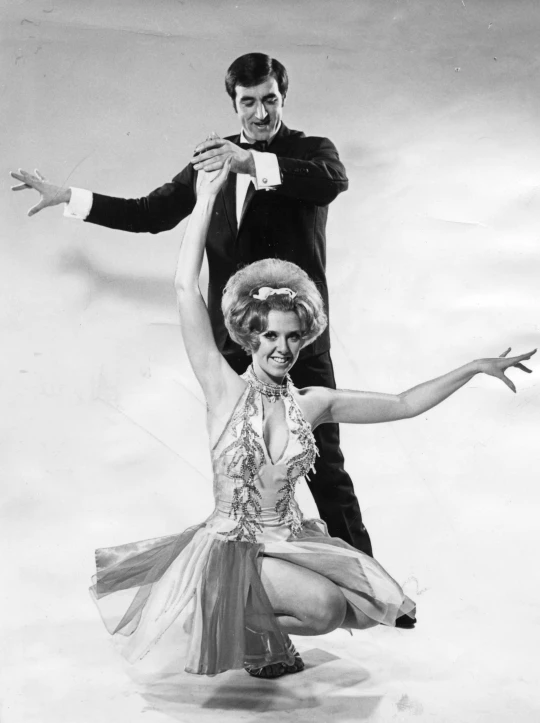Most of us in North America only became familiar with the warm smiling face of Len Goodman with the launch of Dancing with the Stars in 2005. In Britain, Len was already an icon.
This past Monday we learned that he had passed away at the age of 78 (just one day before his 79th birthday), after a brief battle with bone cancer.
He died the way he lived, with class and quiet dignity. He never let on publicly that he struggled with cancer. Years earlier, a similar battle he went through with Melanoma went equally unheralded.
Goodman was one of the UK’s most successful TV personalities, having been associated with the television show Strictly Come Dancing which was exported overseas to Dancing with the Stars.
Quick progress as a professional dancer

Len Goodman won many competitions and titles while partnered with his first wife Cherry Kingston.
Len was born in London in 1944, and eventually worked selling vegetables, following in the footsteps of his grandfather. He also trained as an apprentice welder but dreamed of becoming a professional soccer player. After he injured his foot at the age of 19, his doctor recommended dance to help his recovery.
He excelled at this skill and became a professional in short order, winning various competitions including Dual of the Giants and the British Rising Stars championship. After winning the British Exhibition Championships four times, as well as the World Exhibition Championships, he retired to become a teacher and adjudicator, opening his own dance studio.
Unexpected television stardom
His role as a judge for Strictly almost never happened, as he was asked at the last minute only because another choice for the role turned it down. And so, at the age of 60, he became one of the most famous faces in Britain.
Goodman’s fondness for awarding a score of seven (and the way he said it, putting the emphasis on the last syllable), as well as his announcement of ‘it’s a 10 from Len’ for the best performances, became well-known catchphrases.
But what really endeared people to him was his passion for ballroom dancing, which came through with every comment he made to the stars on the show. He understood the nuances and technical details far better than his Dancing with the Stars co-judges, and it showed. Though often through an artificially gruff demeanor, he would express criticism with warmth and a glint in his eyes.
Unlike the two bookends, Bruno and Carrie-Ann, who treat the role of adjudicator with an over-the-top cartoonish irreverence, Len gave the role the expected level of seriousness. Just as in a court of law, judges should not be reduced to entertainers. Even television’s Judge Judy treats the role with the decorum it deserves.
Dancing with the Stars’ professionals always hung on every word of Len’s feedback, typically ignoring what the others said. When they discussed the performance with their celebrity partners, these professional coaches would always zero in on what Len had said.
Len remained on Strictly for 12 years as head judge, crossing the Atlantic regularly to take on similar duties in the US, before retiring from the British show in 2016.
Ballroom dancing’s cultural influence
Although Dancing with the Stars has created a small amount of interest in ballroom dancing in North America, its influence pales against the impact Strictly Come Dancing has had in Britain.
From the 1920s through the 1960s, ballroom dancing had become one of the most important ways for young people to socialize in the UK. The Daily Mirror estimated in 1950 that over 70% of people met their future husbands or wives while dancing.
By 1959, five million people went dancing every week, in over 3,000 venues across the British Isles. Dance halls provided a form of peer group independence, as well as the benefits of exercise. Interaction between girls and boys in these safe and respectful venues was critical in building cultural values.
Ballroom dancing was one of the most important social and cultural features of 20th century Britain. While a distinction was to grow between “ballroom dancing” of the type featured on Come Dancing (competitive, semi-professional) and the “social dancing” enjoyed by millions in the dance halls of the country, they both drew from the same cultural roots.
Strictly Come Dancing, which began as Come Dancing a few years earlier, renewed that cultural fire throughout the UK. It remains one of the most watched and talked about television programs in Britain.
Dancing with the Stars doesn’t have nearly the same impact in the USA or Canada, as the history of dancing on this side of the Atlantic ocean went through a completely different phase. But it still plays a role in sparking an appreciation of dance. And Len Goodman played a vital role in bringing warmth and gravitas to the cultural experience of watching dance performances. He will be missed.














